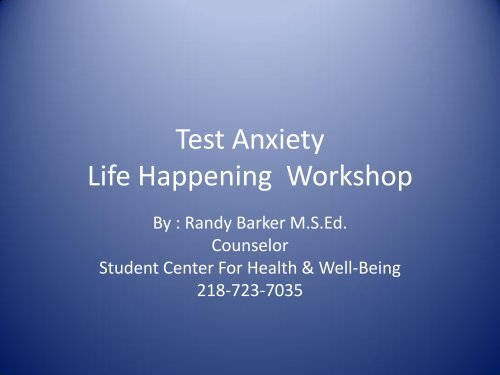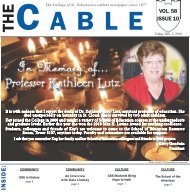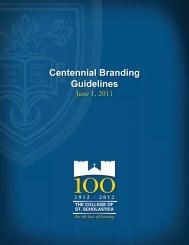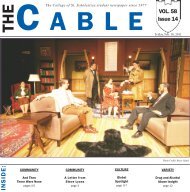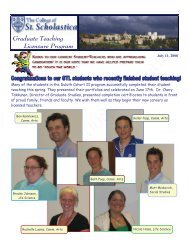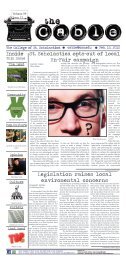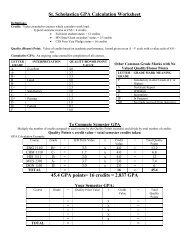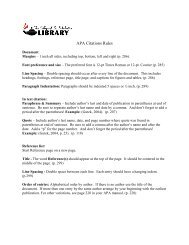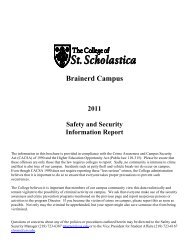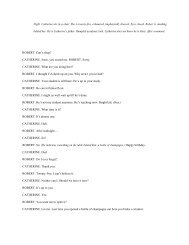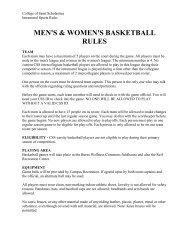Test Anxiety Life Happening Workshop
Test Anxiety Life Happening Workshop
Test Anxiety Life Happening Workshop
Create successful ePaper yourself
Turn your PDF publications into a flip-book with our unique Google optimized e-Paper software.
<strong>Test</strong> <strong>Anxiety</strong><br />
<strong>Life</strong> <strong>Happening</strong> <strong>Workshop</strong><br />
By : Randy Barker M.S.Ed.<br />
Counselor<br />
Student Center For Health & Well-Being<br />
218-723-7035
Normalization:<br />
Most students experience some level of<br />
anxiety during a exam.
Research Has Shown:<br />
• A certain amount of anxiety and worry can be<br />
beneficial. In research comparing test scores<br />
of students who enter exams either<br />
completely relaxed, somewhat anxious or very<br />
anxious, the students who were somewhat<br />
anxious preformed the best.
Problem:<br />
• When test anxiety starts to affect exam<br />
performance negatively it has become a<br />
problem.
What is <strong>Test</strong> <strong>Anxiety</strong>?<br />
• A reaction to anticipating something stressful<br />
• The nervous feeling some get before they take<br />
an exam<br />
• <strong>Test</strong> anxiety has a direct correlation to how<br />
prepared one is for an exam<br />
• It is not genetic<br />
• It is something you’ve learned to do and CAN<br />
be unlearned
Characteristics of <strong>Test</strong> <strong>Anxiety</strong><br />
• Headaches<br />
• Nausea<br />
• Body temperature<br />
changes<br />
• Excessive sweating<br />
Physically:<br />
• Shortness of breath<br />
• Light-headedness<br />
• Rapid heart beat<br />
• Dry mouth
Symptoms of <strong>Test</strong> <strong>Anxiety</strong> Emotionally<br />
• Excessive feelings of<br />
fear<br />
• Disappointment<br />
• Anger<br />
• Depression<br />
• Uncontrollable crying or<br />
laughing.<br />
• Feelings of helplessness
Symptoms of <strong>Test</strong> <strong>Anxiety</strong> Behaviorally<br />
• Fidgeting<br />
• Pacing<br />
• Substance abuse<br />
• Avoidance
Symptoms of <strong>Test</strong> <strong>Anxiety</strong> Cognitively<br />
• Racing thoughts<br />
• Going Blank<br />
• Difficulty concentrating<br />
• Negative Self-Talk<br />
• Feeling of dread<br />
• Comparing yourself to<br />
others<br />
• Difficulty organizing<br />
your thoughts
Where does it come from?<br />
• Lack of preparation/lack of good study skills<br />
• Inadequate information<br />
• Difficulty with time management and<br />
internal/external pressures<br />
• Fear of being evaluated<br />
• Fear of failure<br />
• Perfectionism<br />
• Competition<br />
• Catastrophic thinking
Why The Body Reacts<br />
• It receives a stimulus<br />
• It interprets the meaning of that stimulus.<br />
• It selects a response<br />
• It enlists the body to cooperate as needed.
“If I continue to do what I’ve done, then I<br />
going to get what I’ve always got. “
Exercise #1 Don’t Think About a Pink<br />
Elephant<br />
• This exercise is designed to help see what<br />
trying to suppress and control unwanted<br />
thoughts get you.
Exercise #2<br />
Chinese Finger Trap
Here’s The Good News:<br />
• You can choose a new approach to get a<br />
different result. The goal of this workshop<br />
tonight is to give you several new ways of<br />
doing things to get different results.
“The truth is that our finest moments are most<br />
likely to occur when we are feeling deeply<br />
uncomfortable, unhappy, or unfilled. For it is<br />
only such moments, propelled by our<br />
discomfort, that we are likely to step out of<br />
our ruts and start searching for different ways<br />
or truer answers.” -M. Scott Peck
Research Has Shown:<br />
• that the solution to worry, anxiety and fear is<br />
not more struggle: The solution to your test<br />
anxiety is not to fight “better or harder.”
Findings:<br />
• The solution is to change your relationship<br />
with, and your response to your anxious<br />
thoughts and feelings.<br />
• To get there, you’ll need to learn how to<br />
acknowledge thought and feelings without<br />
“becoming” them and without acting on them<br />
and doing what they say
Exercise #3<br />
Mind Watching
Mind Trap<br />
• When you go beyond seeing words as words<br />
images as images you’re buying into the<br />
illusions your create. The thoughts and<br />
images shift from being thoughts and images<br />
to be something bad such as failing the test,<br />
failing the class. And when that happens you<br />
often find yourself trapped in old behaviors<br />
patterns that are neither helpful nor in your<br />
best interest “ We call this the mind trap.”
Here’s The Key Point:<br />
• Much of your ability to control is based on this<br />
principle: <strong>Test</strong>, exams are anxiety driven only<br />
after we apply meaning to them e.g., A store<br />
is just a store, A speech is just a speech and a<br />
test is just a test.<br />
• When you fuse with your thoughts you tend<br />
to treat them “as if” they were the same<br />
things as the experience or events they<br />
describe.
• F-alse<br />
• E-vidence<br />
• A-pperaing<br />
• R-eal<br />
What is Fear?
Ending Your Struggle with <strong>Anxiety</strong> Is<br />
The Solution<br />
• The good news is that there’s another way: you could give<br />
up the struggle with anxiety-and you could surrender.<br />
• I can drop the rope and end the fight with myself.<br />
• It means allowing yourself to feel anxiety just as it is, just as<br />
it comes, instead of trying not to feel anxiety.<br />
• You can learn to have those unpleasant thoughts and<br />
feelings and learn how to distance yourself enough to do<br />
well on test , exam.
Feeding a Painful Wolf or a<br />
Compassionate Heart<br />
A Native American grandfather was talking to his<br />
grandson about how he felt. He said, “ I feel<br />
as if I have two wolves fighting in my heart.<br />
One wolf is the vengeful, angry, violent one.<br />
The other wolf is the loving ,compassionate<br />
one. “The grandson asked him, “Which wolf<br />
will win the fight in your heart? The<br />
grandfather answered, “The one I feed.”
Story:<br />
The Struggle of the Two Mice
You Control Your Choices, Actions, &<br />
Destiny<br />
• We can conclude that we cannot choose<br />
whether or not we feel anxiety, yet we can<br />
decide what we do with those feelings and<br />
thoughts when they show up.<br />
• In short you’re free to choose how you<br />
respond and what you do.<br />
• Learning to respond differently than you’ve<br />
done in the past is the key to getting unstuck.
What Acceptance Is & Can Do For You<br />
• Acceptance means “to take what is offered.”<br />
• Acceptance is about acknowledging and<br />
experiencing what happened in the past and<br />
what’s happening in the present moment<br />
without getting all tangled up in that experience.<br />
• Anything that is fully experienced will disappear.<br />
As soon as you begin to express an emotion, you<br />
begin to change it.<br />
• Remember, softness will wear away rock-the<br />
hardness that underlies your tendency to struggle<br />
and to fight.
What Acceptance Is & Can Do For You<br />
• Whenever you are highly tense and anxious<br />
you ability to think logically is greatly<br />
diminished. Once you stop the fight with<br />
yourself you have more room to concentrate<br />
on the situation at hand. Any relaxation<br />
technique would increase your ability to think<br />
clearly, and therefore increase self control.
Learning Mindful Acceptance:<br />
• Breathing is our most powerful tool. Our<br />
breathing patterns are always involved in<br />
anxiety, they are either part of the solution of<br />
the problem.
Breathing:<br />
• Once you can control your breathing patterns<br />
you are on the road to success. For some<br />
people indentifying and mastering breathing<br />
patterns will completely end their symptoms<br />
and resolve their problem.
Breathing<br />
• It appears that people under stress not only<br />
begin to increase their respiration rate, but<br />
they also shift from breathing into lower parts<br />
of their lungs to breathing into upper parts.
Breathing<br />
• The habit of slow easy diaphragmatic<br />
breathing invites the “Calming Response”<br />
promoting good health, and providing long<br />
term effects.<br />
• By changing your breathing patterns you can<br />
increase your fight against test anxiety. By<br />
changing your breathing pattern during an<br />
test, or exam you can reverse your body’s<br />
anxiety provoking symptoms.
Two Important Things:<br />
1. Learn to breath from your diaphragm and<br />
make breathing patterns part of your daily<br />
life.<br />
2. Become skilled at shifting to this kind of<br />
breathing whenever you begin to feel<br />
anxious.
Another Important Note:<br />
• Learning skills of meditation can dramatically<br />
increase you ability to control your fearful<br />
thinking by teaching you new ways to respond to<br />
your atomic, thoughts, emotions and images.<br />
• It allows you to step away from these experiences<br />
to become a detached, quite observer of your<br />
thoughts, emotions, and images, as though you<br />
were watching them from the outside.


